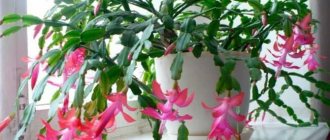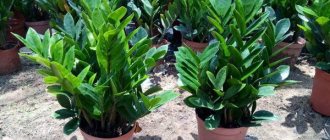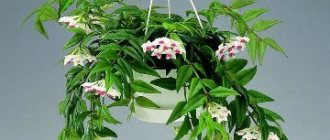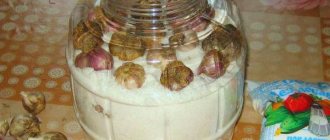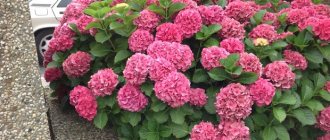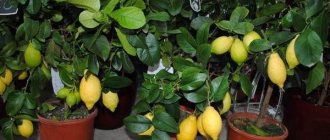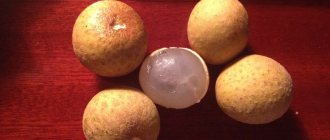What is Hoya/Wax Ivy?
Wax ivy is a tropical, evergreen vine. It is also classified as an ampelous plant. This exquisite plant is called waxy because its leaves have such a coating. It is unpretentious and easy to grow.
The liana develops quickly, and the length of its shoots can reach up to 10 m. The leaves are fleshy, bright green, shiny. Aerial roots form on the shoots.
Young branches are soft and docile. They are used to braid the string, guiding the plant. The older hoyas become, the tougher and less pliable they become, and over time they become woody.
At home, ivy can bloom. However, at this time he becomes moody. Do not move the pot with the plant, otherwise it will drop its buds and you will no longer be able to see them this season.
Wax ivy flowers have an exquisite, delicate aroma. They have the shape of single stars, collected in small baskets-balls of pale pink or white color.
In order for the plant to please with its beautiful appearance, it is cared for as follows:
- Comfortable temperature - +25°C in summer, +15°C in winter. It is resistant to heat, so in the summer it is taken out to the balcony.
- Photophilous. However, you should avoid direct sunlight - you may get burns. In the shade, the flower will begin to shed its leaves. Western windows are considered optimal.
- Watering. From the beginning of spring to the end of autumn it should be abundant. Use soft filtered water, snow, rain, and settled tap water. Carry out immediately as soon as the earthen ball dries out. In winter, their number is reduced - at least three days pass after the ground dries out.
This plant decorates not only a house, apartment, but also office premises. However, few know that its existence is shrouded in mysticism. Some superstitious people claim that it is impossible to keep Hoya at home.
Useful tips
It is best to propagate flowers by cuttings, as they take root very quickly in water or in waterlogged soil. You can choose short cuttings for propagation, the main thing is that each has two growing points and two pairs of leaves.
It happens that for some reason hoya does not bloom. In order for abundant flowers to appear, adhere to some simple conditions. Do not feed this plant often, and in winter, avoid feeding it altogether. In winter, the flower will be uncomfortable in a room where it is too hot. Don't overdo pruning. Hoya loves bright places.
With this care at home, the plant will delight you with its beautiful inflorescences - you have looked after it correctly. Well, how can such beauty bring negativity? Once you see this flowering, it will be difficult to refuse it.
Superstitions
Mythical properties are attributed to various indoor plants - Chinese rose, ampelous and cacti. Among them is wax ivy.
It is believed that hoya can bring misfortune to the house. She scares off the stronger sex. Soon, the wives are quarreling with their husbands, and the adult sons are in a hurry to leave. If the hostess is not married, then her personal life does not work out.
Wax ivy is an energy vampire. It takes all the positive energy from the house and fills it with negative energy. If marital quarrels become more frequent, the plant is considered the culprit. It is not placed in bedrooms and children's rooms, as it is believed to cause insomnia and bring misfortune.
In the house where hoya grows, the financial situation is constantly unstable. Also, there is a sign that people whose room is decorated with hoya often get sick, but this is not so. The plant is not poisonous and does not emit any harmful substances; rather, on the contrary, it purifies the air of impurities.
There is a superstition that the scent of hoya flowers leads to death. Having inhaled its aroma at night, a person may not wake up. This is fundamentally wrong. During flowering, ivy actually emits a scent, but it can only harm those with allergies.
As it turned out, wax ivy is not at all dangerous to keep at home, quite the contrary.
How to care for a flower so that it does not cause harm and takes root?
Wax ivy is very undemanding in terms of conditions and can tolerate many of the mistakes of a novice gardener, but it is still better to adhere to some rules of care:
- For regular flowering and decorative foliage, the plant requires a sufficient level of lighting. It would be ideal to place a pot of hoya on an east or west window.
- When planting, it is necessary to ensure good drainage and light, breathable soil.
- Excessive watering will cause much more harm to your hoya than drying out the soil. Roots easily rot from excess moisture. Water moderately, allowing the soil in the upper half of the pot to dry.
- Wintering at a temperature of about 17 degrees Celsius is desirable.
- You can feed Hoya with fertilizers in spring and summer. Use either fertilizers for flowering plants, but diluted twice as much as directed, or special fertilizers for succulents.
- Hoya does not need spraying - it tolerates dry air well.
Based on the above, we can conclude that hoya is not only completely harmless to the health of people and their pets, but also an extremely unpretentious plant. Myths about its danger are in no way confirmed by science and, having spent very little effort on proper care for it, you can decorate your home with this unusual and highly decorative plant.
If you find an error, please select a piece of text and press Ctrl+Enter.
0
Back
How to grow cyclamen from seeds at home
MORE
Benefits of the plant
If you do not take into account superstitions, hoya is a harmless, beautiful plant and has the following advantages:
- It grows rapidly and rapidly, adding coziness to the room.
- It is considered the strongest natural filter. The plant purifies the air by saturating it with oxygen.
- The plant is unpretentious in care - it grows even in dimly lit rooms.
If you do not take into account superstitions, then hoya is a wonderful plant for decorating an apartment. It is able to please the owner not only with its blooming appearance and lush greenery, but also to purify the air of impurities emitted by household appliances.
Beliefs associated with keeping Hoya at home
Popular rumor likes to attribute sinister properties to climbing plants. And hoya was no exception - they say that this plant cannot be kept in the house because it:
- is an energy vampire;
- drives men out of the house;
- leads to deterioration of health;
- provokes troubles at work;
- releases harmful substances into the air (but scientific research disproves this).
However, there are also positive superstitions about wax ivy. For example, Feng Shui adherents say:
- if you put a hoya in the bedroom, it will strengthen the marriage;
- if you place a climbing plant near doors or windows, this will protect the house from the penetration of negative energy from the outside;
- This beautifully flowering evergreen plant harmonizes the atmosphere of the house, making it more favorable for people.
In addition, there is an opinion that hoya helps to cope with gossips and envious people.
Is it possible to keep Hoya at home?
A superstition has become firmly established in our country, which says that wax ivy brings bad luck to its owner, so keeping such a decorative plant at home is not recommended. Domestic flower growers attribute other mythical properties to hoya:
- vine-like, fast-growing ivy produces very fragrant, single star-shaped flowers, collected in spherical baskets, and during the period when the plant blooms, great misfortunes await the owners of the decorative crop;
- an indoor flower drives men out of homes, makes women unhappy and destroys family happiness;
- a house in which wax ivy is grown very often faces financial problems.
Supporters of this decorative culture claim that indoor hoya is capable of pacifying envious people and gossips, and is also a plant of family happiness, so the only contraindication for growing wax ivy may be an allergy to pollen. Whether to believe signs and superstitions is a personal matter for each gardener, but it is important to remember that all indoor flowers, including hoya, are able to create coziness and also effectively absorb harmful substances or carbon dioxide.
Description
A climbing indoor plant with a large green mass, high decorative qualities of flowers, easy to care for, bringing an idyll to the family, all this is about the beautiful Hoya flower (from the Latin Hoya), also called wax ivy. This indoor climbing flower belongs to the swallow family.
Lastovnevye - a family of plants consisting mainly of climbing plants, less often shrubs or subshrubs, distinguished by opposite (paired) whole leaves. Often this family is not distinguished separately, and the plants are classified as kutraceae.
The name of the flower was given by the traveler and botanist Duke Brown of Northublerne, in whose court there was a garden with exotic plants that he collected during his travels. The greenhouse was looked after by his gardener, Thomas Hoy. Thanks to him, the basic methods and principles of care were obtained.
The genus Hoya contains, according to various sources, from 200 to 500 species. For the most part, these are long-trunked vines of about 6-10 meters. The leaves, as already mentioned, are opposite, come in various sizes, from three centimeters in length in some species, to 6-8 in the majority. A distinctive feature of the foliage of the most common type - waxy - is a fleshy structure and a “rubbed” shiny surface, as if covered with wax. As the stem grows, shoots are formed - aerial roots, characteristic of all vines. At a young age, the shoots are green and quite soft, but over time the stems become woody, so the plant can hardly tolerate changes in location indoors.
A special advantage of Hoya is undoubtedly its peduncle. The flowers form something in the form of balls-inflorescences. The color ranges from white with light purple corollas to dark pink with red.
Corollas - the second and inner row of flower petals in the amount of 3 or 5 pieces.
Each of the flowers of the bouquet is generally small in size, approximately 1-2 cm in diameter, but the Imperial Hoya is known, the flowers of which reach a diameter of 8 cm. The stalk on which the entire inflorescence develops is part of the Hoya, and after the flowering period does not die off , and even becomes larger by the next breeding season. Its homeland and habitat are: mainland Australia, the archipelago of Polynesian islands, Southeast and East Asia. These are all tropical woodlands with enough light and trees for vertical growth.
Diseases and insect parasites
The liana is quite resistant to disease if the plant care is suitable. Typically, pathologies arise due to excessive moisture or lack of light. For example, with a lack of watering, the leaves become small. Fungal diseases occur due to excess moisture and sudden temperature changes. Less commonly, the vine suffers from spotting or rot. Treatment with a copper-soap solution is used as treatment.
If not properly cared for, the plant can be affected by aphids, scale insects and spider mites. Insecticides are used to kill insects. When replanting, the soil must be disinfected. Leaves with a thick blade can be treated with alcohol.
Currently reading:
- Varieties, planting and care of perennial rudbeckia
- Variety of shapes and colors of Calathea from the Marantaceae family
- How to grow Chinese cabbage in open ground
- How to get lush green asparagus after yellowing
Share the news on social networks
About the author: Lyudmila Vasilievna Nosikova
Agronomist of the state agricultural enterprise "Garovskoe" of the Khabarovsk region of the Khabarovsk Territory.
Is it possible to keep wax ivy at home?
Many indoor plant lovers think about this question. Doubts about the advisability of breeding the flower are associated not only with its danger.
There is a belief that ivy keeps men away from home. People even dubbed him a “husband.” In fact, this is just a superstition. And feng shui lovers even dubbed hoya the guardian of family happiness!
Hoya is an unassuming houseplant that brings joy with its charming appearance and unique flowering.
There is a certain danger in keeping hoya at home, because the flower is poisonous. But if you follow safety rules when handling the plant, there will be no problems.
Where is the best place to put it?
There are several options for arranging a plant in which it will bring good luck to the residents of the house:
- You can put the plant in the bedroom. This will make the relationship between lovers more harmonious and warm. Astrologers recommend choosing a type called Heart of Kerry. This variety even has heart-shaped leaves.
- If you place a flowerpot with a flower in the children's room, it will help your children grow up more independent.
- Also, many gardeners place the plant in the living room or dining room. Hoya helps get rid of fatigue and restore strength after a hard day at work.
Reference! You can even place Hoya in your office. If you constantly look after her and do it competently, she will reward her owner with success in her work. The most important thing is to provide the culture with maximum care.
Whether to place a hoya in your home or not, everyone decides for themselves. Undoubtedly, this plant has more positive properties than negative ones. The flower makes the air cleaner and saturates it with oxygen, and also fights skin diseases and simply decorates the interior.
Signs according to the state of the flower
Hoya is an unpretentious plant, which is credited with a wide variety of properties. Depending on what happens to him, you need to prepare for different life situations. There are a number of signs as to whether it is possible to keep indoor ivy at home.
If the hoya blooms at the wrong time, this portends a misfortune in the family, which can lead to the death of a person.
If the wax ivy begins to dry out, then you should pay attention to your surroundings; perhaps an enemy has appeared among your loved ones. The flower absorbed his negative energy, thereby protecting the inhabitants of the house.
If the leaves begin to turn yellow, then you should pay attention to the health of your household. Yellowing leaves indicate that there is unhealthy energy in the house, and it is worth taking appropriate measures to improve it.
Reproduction methods
Seeds
The seeds are removed from the pods, slightly dried, and sown in a breathable soil substrate. We use fresh seeds; less than a year must have passed since their collection. After 7 days, the first shoots appear, which require good lighting and moisture. After 3 months, the plants are planted in separate pots.
By layering
An adult plant is propagated by stem layering. The shoot is cut shallowly, wrapped in damp moss, wrapped in film, and the edges are strengthened with thread. After 10 days, roots form, after which the film is removed, the rooted shoot is cut off and planted in a breathable substrate.
Cuttings
When propagating hoya from stem cuttings, take into account the age and size of the cutting.
It is best to use specimens with 2 nodes covering 2 pairs of leaves, as they grow new shoots faster.
The apical cuttings take root worse, so you need to choose mature but not yet lignified cuttings. Under the knot you need to leave a section a few centimeters long. When a shoot appears from a node, the second node is cut off and also rooted.
Botanical characteristics
Hoya (Hoya) from the Lastovnevye family can be represented by a shrub, liana or hanging plant. Hoya has strong stems on which opposite leaves are located. The foliage can be leathery or succulent, oval or pointed in shape. Foliage color can be varied. The most popular varieties in indoor floriculture are those with dull green and dark green leaves, as well as plants with green leaves with yellow, cream or pink spots.
The flowers are waxy, with an unusually pleasant and quite pronounced aroma. Umbrella inflorescences can include a different number of relatively small star flowers, the color of which varies depending on the species and varietal characteristics of the ornamental crop. Droplets of nectar on the surface of the flowers only add to the attractiveness of this amazingly beautiful plant.
Feng Shui meaning
You shouldn’t even think about whether you can keep wax ivy at home. According to the ancient teachings of Feng Shui, this plant brings only happiness to its owners. The miraculous flower strengthens family relationships and makes all residents of the house strive for harmony.
True, Buddhists warn that hoya made of wax, plastic, fabric and other material can cause trouble. According to Feng Shui, it is strictly forbidden to keep artificial flowers in the house.
The teachings of the Taoist sages say that the best place for a plant is the bedroom. The flower creates a favorable atmosphere that promotes reconciliation between lovers and stimulates sexual energy.
The couple develops a correct worldview: lovers strive for harmony, do not violate each other’s personal space and become less prone to psychological violence.
If there are children in the house, the hoya should be placed in the living room so that positive energy spreads to all residents of the house.
